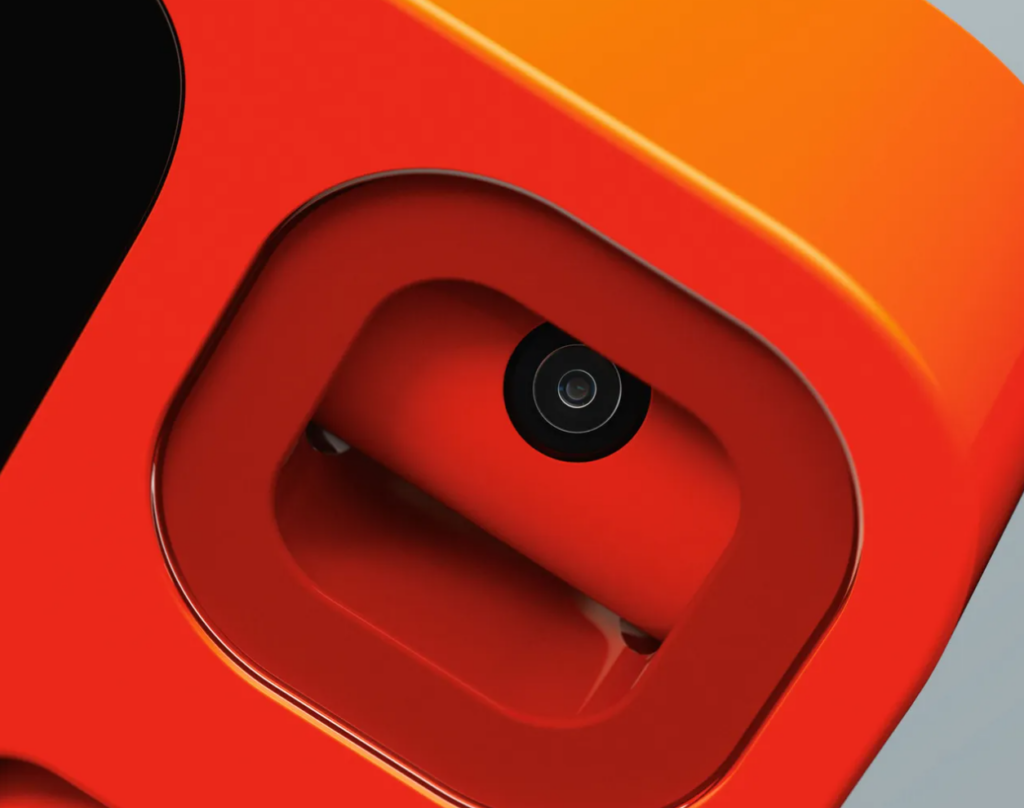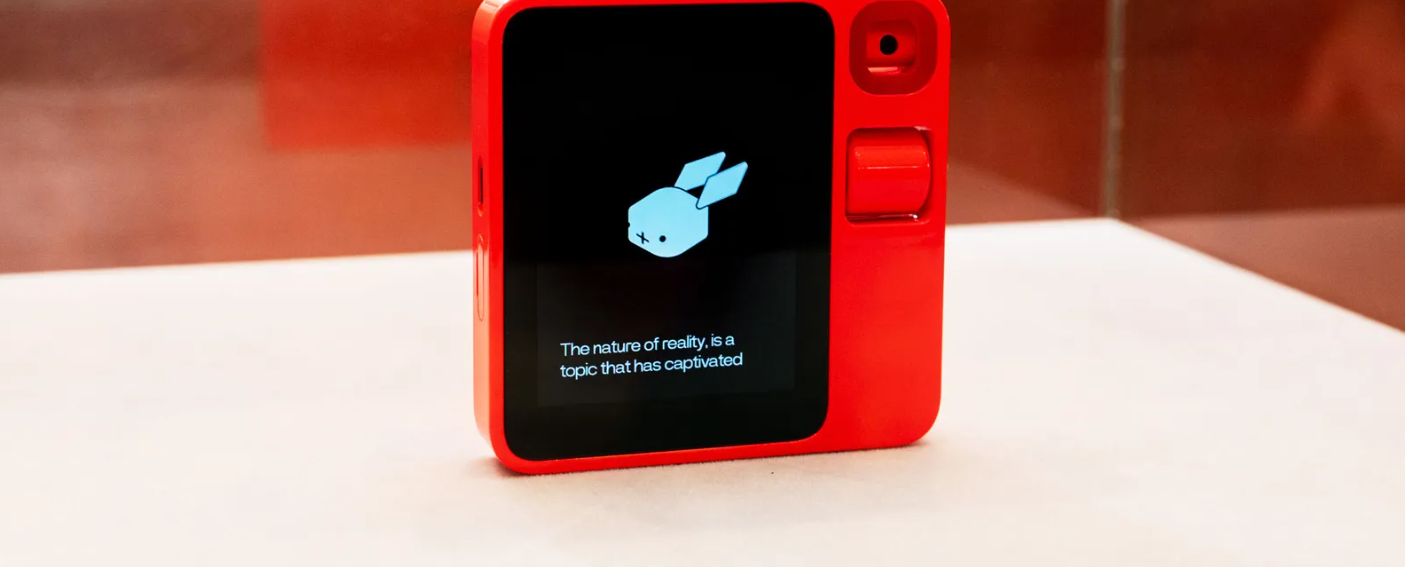“Get Ready for Rabbit R1: CES 2024 Unveils the Compact Personal Assistant Set to Launch in March! Packed with Intelligent Voice Commands, Scroll Wheel, and Camera, this Pocket-Sized Device Utilizes Large Action Models (LAMs) for Customizable Tasks.”
Meet the Rabbit R1, the futuristic AI assistant unveiled by Rabbit at CES 2024.
First things first, the Rabbit R1 isn’t tethered to your phone or home speaker – it’s a standalone gadget, bringing simplicity and innovation right to your fingertips.
Developed in collaboration with the Swedish design firm Teenage Engineering, the R1 emerges as a pocket-sized square in a striking red-orange hue, akin to the dimensions of a stack of Post-It notes. Its design is streamlined, featuring a 2.88-inch touchscreen and a user-friendly analog scroll wheel.
At the wheel’s summit rests the distinctive “Rabbit Eye,” a 360-degree rotating camera. Noteworthy for its privacy-centric design, the camera points away when not in operation, doubling as a default privacy shutter for enhanced user confidentiality.
Jesse Lyu, the visionary mind behind Rabbit, dreams of a world where tasks are seamlessly accomplished without the need to fumble through various apps.
“We’ve reached a juncture where our smartphones are cluttered with hundreds of apps featuring complicated user interfaces that struggle to communicate with one another,” remarked Jesse Jyu, the founder and CEO of Rabbit.
“As a result, this frustration among end-users, frequently feeling lost in the complexity, has led Rabbit to strive for a more intuitive, app-free experience empowered by the capabilities of AI,” explains Jesse Jyu, the founder and CEO.
He added, “Large Language Models, such as ChatGPT, demonstrated the potential of comprehending natural language through AI. Our Large Action Model takes this a step further: it doesn’t merely generate text as a response to human input—it executes actions on behalf of users, facilitating the accomplishment of tasks.”
Operating the R1 is designed to be refreshingly simple: just press and hold the push-to-talk button, express your command, and let the device take care of the rest.
Whether you’re calling an Uber, reserving a dinner spot, or adding a song to your Spotify playlist, the R1 condenses it all into a single, effortless voice command.

But how does the R1 achieve these tasks without relying on conventional apps or APIs? The key lies in the Rabbit OS, functioning as a layer that facilitates access to different services via a web portal called the Rabbit Hole.
Users log into their accounts on this portal, giving the R1 the authority to execute actions on their behalf. Additionally, the R1’s microphone activates only when you press the push-to-talk button. This ensures that the device isn’t continuously listening, providing a subtle nod to user privacy, a feature often overlooked in our ever-present smartphones.
Behind the scenes, the R1 operates with a combination of large language models (LLMs) and Rabbit’s own large action models (LAMs).
Think of LAMs as learners – they watch how people use different interfaces and copy those actions. This learning process is the secret sauce that enables the R1 to perform various tasks, getting better and learning more as time goes on.
One fascinating feature of the R1 is its experimental “teach mode,” giving users the ability to train the device in new tasks. Picture this – you demonstrate to your R1 how to edit a photo or play a specific game, and it learns to replicate those actions on its own. It’s like having a personalized assistant that adapts to your needs through hands-on training.
The developers even used the R1 to perform simple functions in Diablo IV.
At a quite reasonable $199, the Rabbit R1 is positioned more as an accessory than a smartphone replacement.
Pre-orders are currently available, and the anticipated shipping date in late March signals the R1’s ambition to redefine how we engage with technology. This affordable yet innovative device aims to complement your tech experience rather than replace it.
The Rabbit R1 undeniably sparks curiosity with its affordable price tag. However, the true test lies in its utility— a challenge that the first generations of AI devices must overcome to demonstrate their worth. Only time will reveal the impact and practicality of this intriguing gadget.
Rabbit R1: A Closer Look at Its Features
Here’s a quick overview of what we know about the Rabbit R1:
- Size and Display: The R1 is smaller than an iPhone and fits in your pocket. It comes with a 2.88-inch touchscreen.
- Power and Storage: Inside, the R1 runs on a strong 2.3GHz MediaTek processor, with 4GB of memory and 128GB storage.
- Rotating Camera: A cool feature is its spinning camera, allowing you to point it towards you or away for privacy.
- User Interaction: To use it, just press the “Push-to-Talk” button, and the Rabbit OS will listen and follow your commands.
- Connectivity: Stay connected with a 4G LTE SIM slot, Wi-Fi, and charge it easily with USB-C.
- Battery Life: Rabbit claims it lasts all day on a single charge.
- Large Action Model (LAM): The R1 uses the Rabbit OS and a Large Action Model, letting it perform tasks without traditional apps.
- Capabilities: It can do various tasks, like booking an Uber or suggesting recipes. It learns and copies actions, as seen in a demo where it created an image using Midjourney via Discord.
- Rabbit Hole Portal: Use a training mode to teach it new tricks. Manage services through the Rabbit Hole web portal.
The launch of the Rabbit R1 signifies a thrilling advancement in AI technology, presenting a mix of style, practical versatility, and user-friendly design.
Its emphasis on privacy in design and product messaging seems to be a subtle departure from the Humane AI Pin, which faced criticism for its camera directly observing daily activities.



